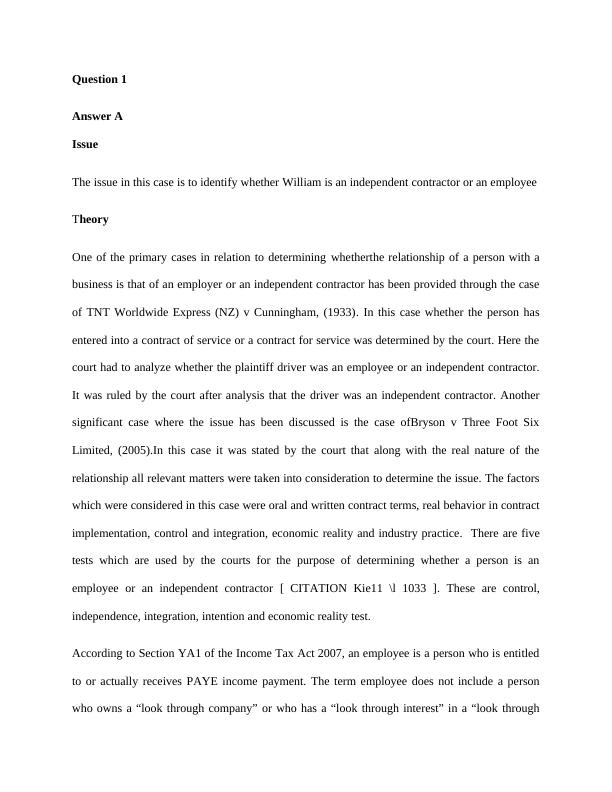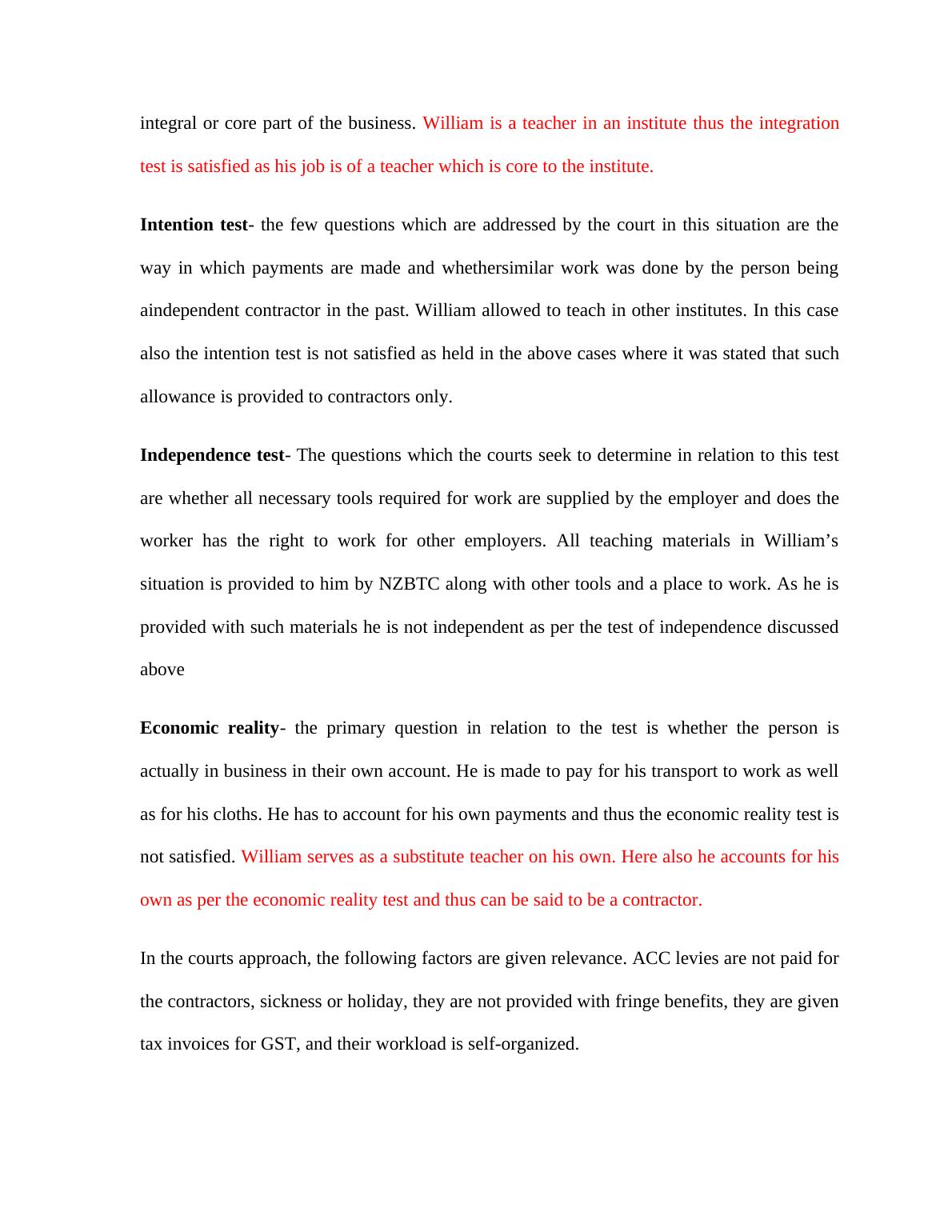The Employment Status - Assignment
8 Pages2046 Words84 Views
Added on 2021-04-16
The Employment Status - Assignment
Added on 2021-04-16
ShareRelated Documents
Question 1Answer AIssue The issue in this case is to identify whether William is an independent contractor or an employeeTheory One of the primary cases in relation to determining whetherthe relationship of a person with abusiness is that of an employer or an independent contractor has been provided through the caseof TNT Worldwide Express (NZ) v Cunningham, (1933). In this case whether the person hasentered into a contract of service or a contract for service was determined by the court. Here thecourt had to analyze whether the plaintiff driver was an employee or an independent contractor.It was ruled by the court after analysis that the driver was an independent contractor. Anothersignificant case where the issue has been discussed is the case ofBryson v Three Foot SixLimited, (2005).In this case it was stated by the court that along with the real nature of therelationship all relevant matters were taken into consideration to determine the issue. The factorswhich were considered in this case were oral and written contract terms, real behavior in contractimplementation, control and integration, economic reality and industry practice. There are fivetests which are used by the courts for the purpose of determining whether a person is anemployee or an independent contractor [ CITATION Kie11 \l 1033 ]. These are control,independence, integration, intention and economic reality test. According to Section YA1 of the Income Tax Act 2007, an employee is a person who is entitledto or actually receives PAYE income payment. The term employee does not include a personwho owns a “look through company” or who has a “look through interest” in a “look through

company” other than where he is a working owner. (A look-through company is a tax structurein NZ having limited liability, through which the income and expenditure of the company can bedirectly transferred to the shareholders)Application In the provided situation the five tests are to be employed in order to determine theemployment status of William Ross. Control- In this test the court determines the right of the employer in relation to controllingthe way in which work is done. For instance, the right to pay, dismiss or choose theemployee. In the given situation William is not required to wear a specific uniform and isonly asked to come on time and be dressed in a professional manner. This means he isprovided independence and there is no control on what he wears.Restrictions have beenimposed on him in relation to acceptance of excessive gifts and being involved in any formof intimate relationship with the clients. In the given situation there is no control on the wayhe teaches but on his behavior professionally. Thus the control test is not satisfied.He has toattend teaching committee meetings every semester. There is some level of control which isexercised on him. This includes the restrictions imposed on him in relation to how he doeshis work. Thus the control test is not satisfied in the balance of probability. Integration or organization test- in relation to this test the court determines whether thesame work is done in a similar manner by other employees and whether the work is anintegral or core part of the business. William is a teacher in an institute thus the integrationtest is satisfied as his job is of a teacher which is core to the institute.

Intention test- the few questions which are addressed by the court in this situation are theway in which payments are made and whethersimilar work was done by the person beingaindependent contractor in the past. William allowed to teach in other institutes. In this casealso the intention test is not satisfied as held in the above cases where it was stated that suchallowance is provided to contractors only.Independence test- The questions which the courts seek to determine in relation to this testare whether all necessary tools required for work are supplied by the employer and does theworker has the right to work for other employers. All teaching materials in William’ssituation is provided to him by NZBTC along with other tools and a place to work. As he isprovided with such materials he is not independent as per the test of independence discussedaboveEconomic reality- the primary question in relation to the test is whether the person isactually in business in their own account. He is made to pay for his transport to work as wellas for his cloths. He has to account for his own payments and thus the economic reality test isnot satisfied. William serves as a substitute teacher on his own. Here also he accounts for hisown as per the economic reality test and thus can be said to be a contractor.In the courts approach, the following factors are given relevance. ACC levies are not paid forthe contractors, sickness or holiday, they are not provided with fringe benefits, they are giventax invoices for GST, and their workload is self-organized. Taxable income is reduced when a person converts from an employee to a contractor as theyare provided additional deductions for claimed expenses. Thus, in their approach IRD arevery vigilant.

End of preview
Want to access all the pages? Upload your documents or become a member.
Related Documents
case study on tax law Assignmentlg...
|8
|1479
|24
Assignment Solution 1 Issue Whether Amanda is an employee or an independent contractor of Monks Pty. Ltd? Lawlg...
|7
|1764
|415
Assignment on Employment Lawlg...
|7
|1822
|38
Business Law Assignment - Hollis v Vabu Pty Ltdlg...
|9
|1966
|103
Case Study on Yum Yum Pizzalg...
|9
|1959
|266
Difference between employee and independent contractor | Lawlg...
|7
|1133
|312
